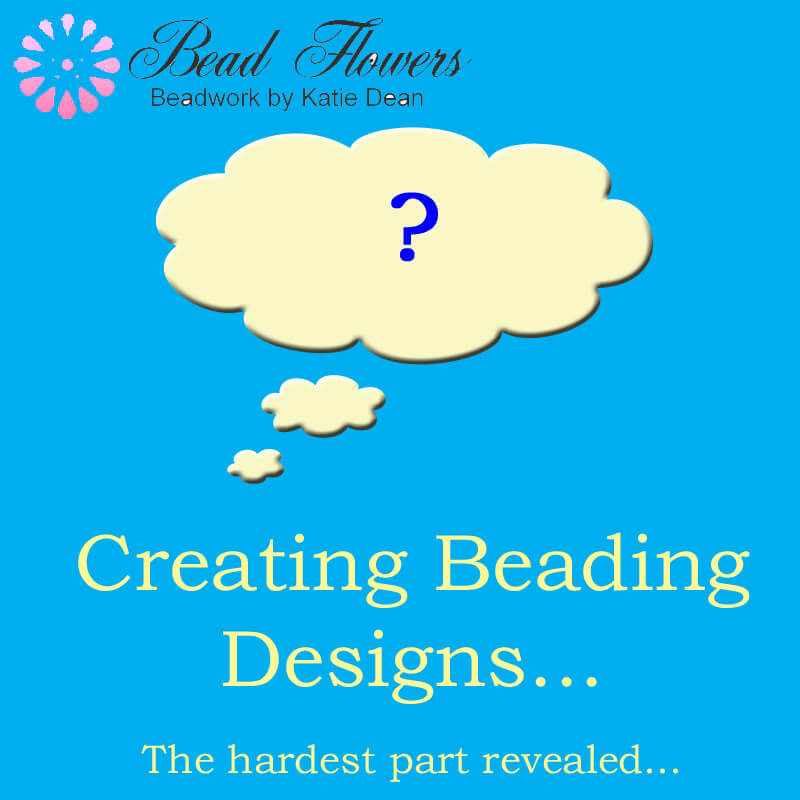
I get lots of questions about my process for creating beading designs. The most common is probably, ‘where do you get your ideas?’
But did you know, that’s actually not the most difficult part of the design process?
Any ideas what is more difficult…? Keep reading if you want to find out…
The process of creating beading designs
If you’ve never done any designing yourself, have you thought about how the process might work? I like to think of it in three stages…
Stage 1: the idea
You’re not going to get very far in creating beading designs without an idea. So, how does that happen?
The first source…
Sometimes other people suggest something. That’s been happening to me more and more. So, I’ll get an email or a comment on Facebook to say, could you make X?
Now, I like a challenge. So, I will always give any suggestions some serious thought. And, over the years, I’ve made quite a few. If you’ve been following along with my 2019 beaded bead challenge, you’ll know I’ve actively been asking for suggestions. (I’ve also made several of them, so far, with more in the pipeline).
Browse all the beaded bead patterns to find these projects>>
The second source…
…is just inspiration. Everyone has that. Maybe you look at a flower in your garden and think how you could make it in beads. Maybe you see a colour scheme in a dress fabric, or in nature. That leads to a design in that colouring. Or, if you’re anything like me, maybe you’re wandering down the aisles of your local supermarket and realise that some cakes would make great beading projects!
So, my point is, inspiration can come from anywhere and can strike at any time.
Find all these patterns in Sweet Treats book, here>>
The third source…
…comes from the beads themselves. Quite simply, just take out some beads and thread (or wire, or whatever your favourite medium) and start to experiment. This is the ‘what if’ process. What if I string the beads that way? What if I mix this bead with that bead? The result: experimental thread paths, interesting motifs… and lots of ‘frog stitch’.
Find all these projects in this section>>
So, in that sense, the first stage of creating beading designs is pretty straightforward.
Stage 2: Making it
Whatever you set out to make, you’re going to have lots of possibilities open to you.
You need to decide on colouring. Then, think about techniques: which is likely to work best?
After that, it’s just about experimenting. Literally, taking the beads out, trying the stitch you think will work and modifying as you go.
In every project, you will find some things that work as planned and some that don’t. Sometimes the beads take you in unexpected directions. Other times you may hit a problem that seems insurmountable. Perhaps the solution will present itself after a good night’s sleep. Or perhaps you have to shelve the project for a while.
The idea may still bubble around in your head. But you need to create some other projects, or learn some new techniques before you discover that magic solution.
So, the second stage of creating beading designs can be quite frustrating.
Stage 3: Writing a pattern
Now, if you’re wanting to earn any kind of income from your beading, you will have to write up instructions for your design. Whether you do that in a book, as a pattern, or on a video, you will face the same challenge…
Can you recreate what you did in a manner that will let other people do it as well?
So, I’m going to suggest that the hardest part of creating beading designs is actually writing the instructions.
How did I reach this conclusion? Well, let me share a little story with you…
A sewing machine beaded box
Now, who would come up with such a crazy idea? One of my customers actually…
I think it was shortly after I had launched my camera beaded box. One of my very good customers wrote and asked if I could make a sewing machine box.
So, I thought about this for a short while. The shape should be do-able. I could envisage how that structure would work. So, why not?
That was part one of the process for creating beading designs checked off.
Now, what about parts two and three?
The design process
This is where I had that lightbulb moment. You probably don’t realise it, but all the time I’m sitting and beading, I’m also thinking about how I will write the instructions.
Will I need photos, or would diagrams be better? Maybe I need both…
Will this section need a chart, or a table, or a long explanation?
Did you realise the answers to those questions can actually dictate how I create a design?
So, in this case, the sewing machine turned out as it did because of the constraints of having to write the pattern.
I actually created the base section in a completely different way. This took me several hours. Then, at the end of it, I thought: ‘how am I going to write that up?’ I had created a design process that I could replicate. I even went as far as taking the photos, drawing the diagrams and starting to write the instructions. But none of it felt ‘right’.
Then, I had a total change of heart. I saw another way in which I could create the same base. This new way would be a lot easier to explain and document for others. So, I ripped out all my work, deleted all the words and diagrams and started over.
Many hours later, I ended up with the box and the pattern that you see on my website now.
So, I think it was at that moment that I decided the hardest part about creating beading designs is being able to document them for others…
The moral…
There isn’t a moral to this story. But I am curious…
Do you agree with me?
What do you think of my claim about this being the hardest part of creating beading designs?
…and does my answer surprise you?
Let me know your thoughts in the comments below…












